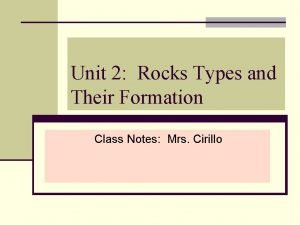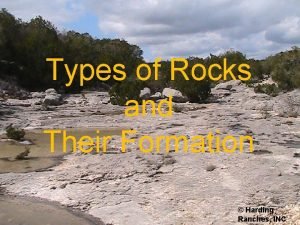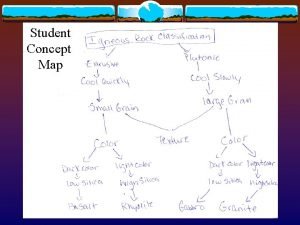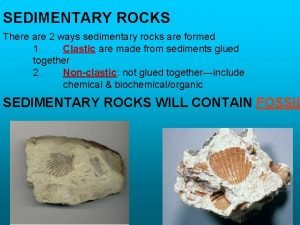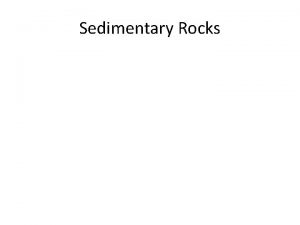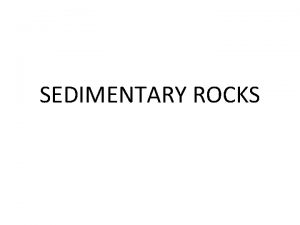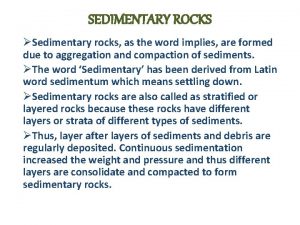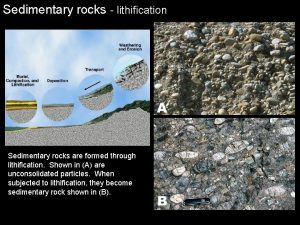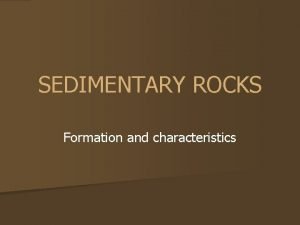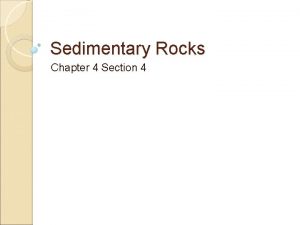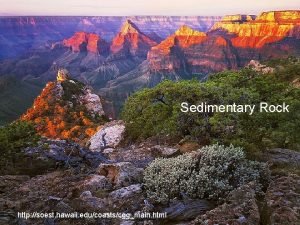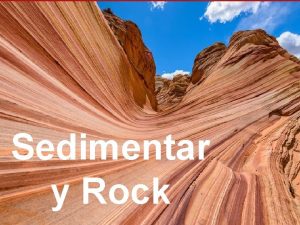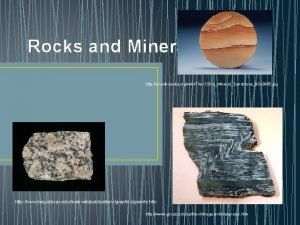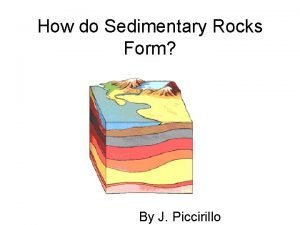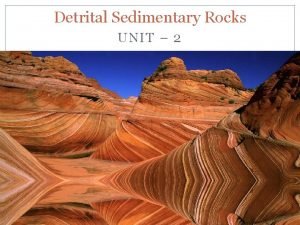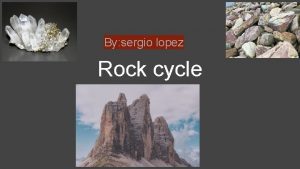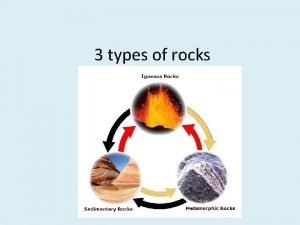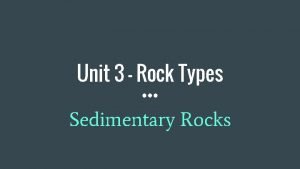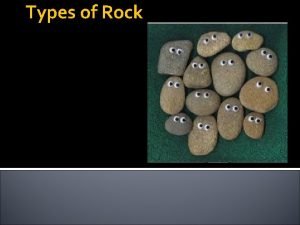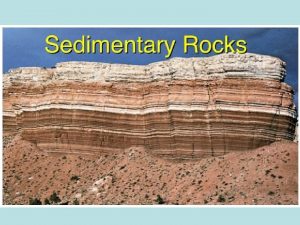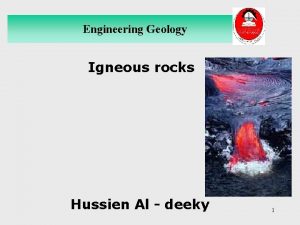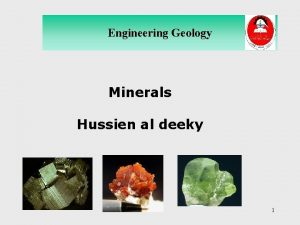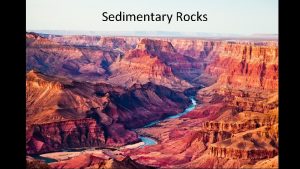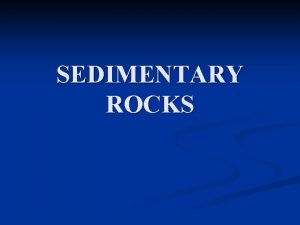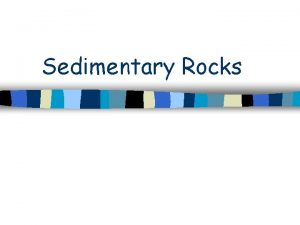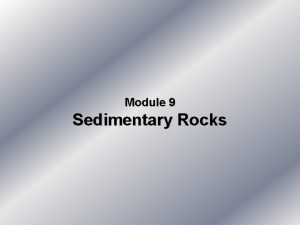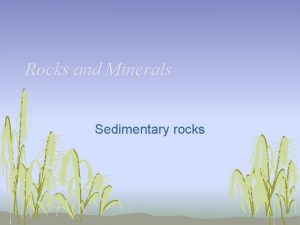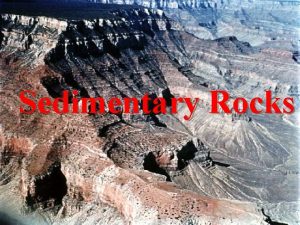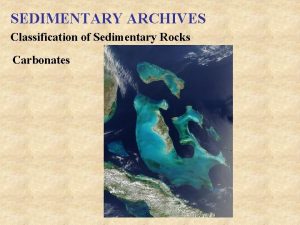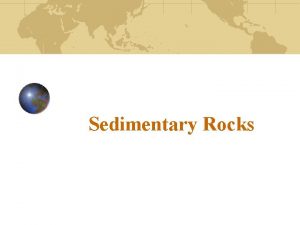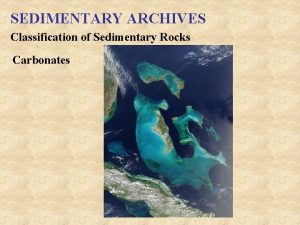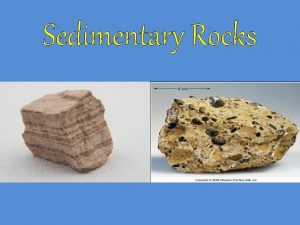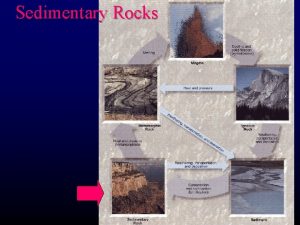Engineering Geology Sedimentary Rocks Hussien Al deeky 1

































- Slides: 33

Engineering Geology Sedimentary Rocks Hussien Al - deeky 1

Engineering Geology Definition Sedimentary rock is a type of rock that is formed by sedimentation of material at the Earth's surface and within bodies of water. Sedimentation is the collective name for processes that cause mineral and/or organic particles (detritus) to settle and accumulate or minerals to precipitate from a solution. Particles that form a sedimentary rock by accumulating are called sediment. Before being deposited, sediment was formed by weathering and erosion in a source area, and then transported to the place of deposition by water, wind, mass movement or glaciers. 2

Engineering Geology - Sedimentary rock is formed by deposition and consolidation of minerals and organic materials and from precipitation of minerals from solution. The processes that form sedimentary rock occur at the surface of the earth and within bodies of water. -Rock formed from sediments covers 70 -80 % of the earth’s land area, and includes common types such as limestone, chalk, sandstone, conglomerate and shale. -Sedimentary rocks are only a thin veneer over a crust consisting mainly of igneous and metamorphic rocks and constitute a total of 5% of the earth crust volume. -Sedimentary rocks are deposited in layers as strata, forming a structure called bedding. The study of sedimentary rocks and rock strata provides information about the subsurface that is useful for civil engineering, for example in the construction of roads, houses, tunnels canals or other constructions. Sedimentary rocks are also important sources of natural resources like coal, fossil fuels, drinking water. 3

Engineering Geology Rock Cycle Diagram 4

Engineering Geology 5

Engineering Geology Weathering Changes that take place in a rock exposed the earth’s surface: 1. Mechanical weathering : breaking larger pieces into smaller pieces (clasts), with no change of chemical composition ( clastic Rocks) 2. Chemical weathering : original minerals partially dissolve, and new minerals form that are more stable at the lower temperature and pressure, and more moist environment at the earth’s surface 6

Engineering Geology Sediments • Sediments: are particulate matter derived from physical or chemical weathering of the earths crust which are subsequently transported by wind, water or ice. 7

Engineering Geology Sediment transport & deposition • Sediment is transported by wind, water and ice. Ice is a solid and so can carry sediment particles of any size, but wind transports only sand smaller particles. The most prolific transport agent is running water. The larger the particle size, the more vigorous the current required for transport. • Whether transported by water, wind, or ice, sediment eventually accumulates in a geographic area known as a depositional environment. 8

Weathering products are separated by transportation. • The quartz settles quickly and form rocks such as sandstone and siltstone. • The clay stays in suspension until it settles to form shale and mudstone. • The dissolved Ca. CO 3 precipitates to form limestone or dolomite 9

Engineering Geology • Abrasion during transport reduces particle size and smoothes sharp corners, a process known as rounding. • Transport & depositional processes influence sorting, which refers to the variety of particle sizes present in a sediment or sedimentary rock. Sorting and rounding provide information that can help decipher the history of a sedimentary deposit well-rounded, well-sorted gravel angular, poorly sorted gravel 10

Engineering Geology Lithification : is a process by which soft and loose sediments are converted into hard and firm rocks. Consolidation is of three types: 1. Compaction and Dehydration: The squeezing out of water from the pores of the sediments and its changing to solid mass by cohesion between the particles and pressure from overlying rock is called compaction and dehydration. 2. Cementation: Many coarse grained sediments are consolidated by cementation, which is the process of precipitation of some cementing materials, for example, silica, calcium carbonate, iron oxides and clay minerals. 3. Crystallization: Chemically formed sedimentary rocks such as limestone, dolomites, gypsum etc are consolidated chiefly by the crystallization of their constituents. 11

Engineering Geology Structural features of sedimentary rocks are of great value in determining their origin. The main structures are as follows: 1 -Stratification: The deposition of sediments into layer or beds is called stratification. The thickness of a single bed may vary from a few centimeters to many meters. The stratification is formed due to the following. I. Difference in the kinds of materials deposited for example shale and lime stone II. Difference in the size of particles deposited for example coarse grained and fine grained sandstone beds III. Difference in the color of the materials deposited for example light grey and dark grey layers of limestone 12

Engineering Geology Lamination: Thin bedding, less than one centimeter in thickness, are called lamination. It is usually fined grained sedimentary rocks like shales. Cross-bedding: It is also called current bedding or false bedding. Cross-bedding are the minor bedding or lamination which lie at an angle to the planes of general stratification. This structure is found in shallow water and wind formed deposits.

Engineering Geology Strata- Bedding Planes 14

Engineering Geology Cross bedding

Engineering Geology Classification of Sedimentary Rocks 1 -Clastic sedimentary rocks: are formed from the mechanical break up of other rocks and are classified based on the particle size, e. g. sandstone. Closer to the source the grains will tend to be larger and more angular These rocks are classified by the size of their constituent particles Sediment Name & Size Description Rock Name gravel (>2 mm) rounded gravel angular gravel Conglomerate breccia sand (1/16 -2 mm) >25% feldspar mostly quartz Arkose sandstone silt (1/16 -1/256 mm) mostly siltstone clay (<1/256 mm) mostly clay Claystone 16

Engineering Geology Conglomerate and composed of round gravel breccia are composed angular gravel 17

Engineering Geology. 2 -Chemical sedimentary rocks : are formed of ions taken into solution by chemical weathering of parent material. Many have crystalline texture of interlocking mineral grains. These rocks are classified based on their mineral composition. Texture Compostion Varies calcite (Ca. CO 3 ) Varies dolomite [Ca. Mg (CO 3)2] Crystalline gypsum (Ca. So 4. 2 H 2 O) Crystalline halite (Na. Cl) * most limestone is biochemical ** dolostone is chemically altered limestone Rock Name *limestone **dolostone rock gypsum rock salt . 18

Engineering Geology rock gypsum rock salt

Engineering Geology 3 -Biochemical sedimentary rocks are formed of ions taken into solution by chemical weathering of parent material, as are chemical sedimentary rocks. Organisms aid in the precipitation of biochemical sedimentary rocks Texture *clastic Crystalline Composition Rock Name calcite (Ca. CO 3 shells, etc. ) limestone altered microscopic shells chert carbon from altered plant remains coal * composed of individual particles or grains, fragments of shells or similar grains in the case of biochemical limestone 20

Engineering Geology Chert Coal 21

Engineering Geology Engineering Considerations of Sedimentary Rocks (1)The sedimentary rocks also have the Alkali-silica reaction problem when used as aggregates with Portland cement. The sedimentary rocks with this problem are chert and graywacke. (2)Fine-grained sedimentary rocks like limestone and dolomite are the best for being used as aggregates; siltstone, shale, conglomerate, and quartz sandstone are not acceptable; (3)Stream and terrace gravel contains weak pieces, they are not good for aggregates in concrete. Weathered chert , shale, and siltstone can cause pop-outs at the concrete surface after freeze-thaw cycles; (4)Coarse-grained limestone is not good for aggregates by reducing particle size; (5)Sinkhole problem in carbonate terrains due to the high dissolvability of limestone and dolomite 22

Engineering Geology 23

Engineering Geology 24

25

Conglomerate is a clastic sedimentary rock that contains large (>2 mm in diameter) rounded particles. The space between the pebbles is generally filled with smaller particles and/or a chemical cement that binds the rock together 26

Breccia is a clastic sedimentary rock that is composed of large (over two millimeter diameter) angular fragments. The spaces between the large fragments can be filled with a matrix of smaller particles or a mineral cement which binds the rock together 27

Sandstone is a clastic sedimentary rock made up mainly of sand-size (1/16 to 2 mm diameter) weathering debris. Environments where large amounts of sand can accumulate include beaches, deserts, flood plains and deltas 28

Shale is a clastic sedimentary rock that is made up of clay-size (less then 1/256 mm in diameter) weathering debris. It typically breaks into thin flat pieces 29

Siltstone is a clastic sedimentary rock that forms from silt-size (between 1/256 and 1/16 mm diameter) weathering debris 30

Limestone : composed primarily of calcium carbonate. It can form organically from the accumulation of shell, coral, algal and fecal debris. It can also form chemically from the precipitation of calcium carbonate from lake or ocean water. Limestone is used in many ways. Some of the most common are: production of cement, crushed stone 31

Rock Salt is a chemical sedimentary rock that forms from the evaporation of ocean or saline lake waters. Known as "halite". It is often mined for use in the chemical industry or for use as a winter highway treatment. Some halite is processed for use as a seasoning for food 32

Coal : organic sedimentary rock that forms mainly from plant debris. The plant debris usually accumulates in a swamp environment. Coal is combustible and is often mined for use as a fuel 33
 Igneous rock to metamorphic rock
Igneous rock to metamorphic rock Compaction and cementation
Compaction and cementation Https://geology.com/rocks/
Https://geology.com/rocks/ Sedimentary weathering
Sedimentary weathering Esrt sedimentary rocks
Esrt sedimentary rocks Sedimentary rocks examples
Sedimentary rocks examples Concept map for igneous rocks
Concept map for igneous rocks Organically formed sedimentary rocks
Organically formed sedimentary rocks What is the name of this rock
What is the name of this rock Detrital sedimentary rocks
Detrital sedimentary rocks Define bioclastic
Define bioclastic Characteristics of sedimentary rocks
Characteristics of sedimentary rocks What are sedimentary rocks
What are sedimentary rocks In sedimentary rocks lithification includes
In sedimentary rocks lithification includes Features of sedimentary rocks
Features of sedimentary rocks Sedimentary igneous rocks
Sedimentary igneous rocks Sorting sedimentary rocks
Sorting sedimentary rocks Clastic sedimentary rocks
Clastic sedimentary rocks Sedimentary rocks in hawaii
Sedimentary rocks in hawaii Fun facts about sedimentary rocks
Fun facts about sedimentary rocks Esrt sedimentary rocks
Esrt sedimentary rocks Characteristics of sedimentary rocks
Characteristics of sedimentary rocks Classify sedimentary rocks
Classify sedimentary rocks Formation of sedimentary rocks leaving cert
Formation of sedimentary rocks leaving cert Esrt sedimentary rocks
Esrt sedimentary rocks Biochemical sedimentary rocks
Biochemical sedimentary rocks Clasts detrital minerals
Clasts detrital minerals Attritiom
Attritiom Sedimentary and metamorphic rocks section 6.1
Sedimentary and metamorphic rocks section 6.1 Facts on sedimentary rocks
Facts on sedimentary rocks Metamorphic rocks form from
Metamorphic rocks form from Shale rock classification
Shale rock classification Coarse grained rock examples
Coarse grained rock examples Types of sedimentary rocks
Types of sedimentary rocks




